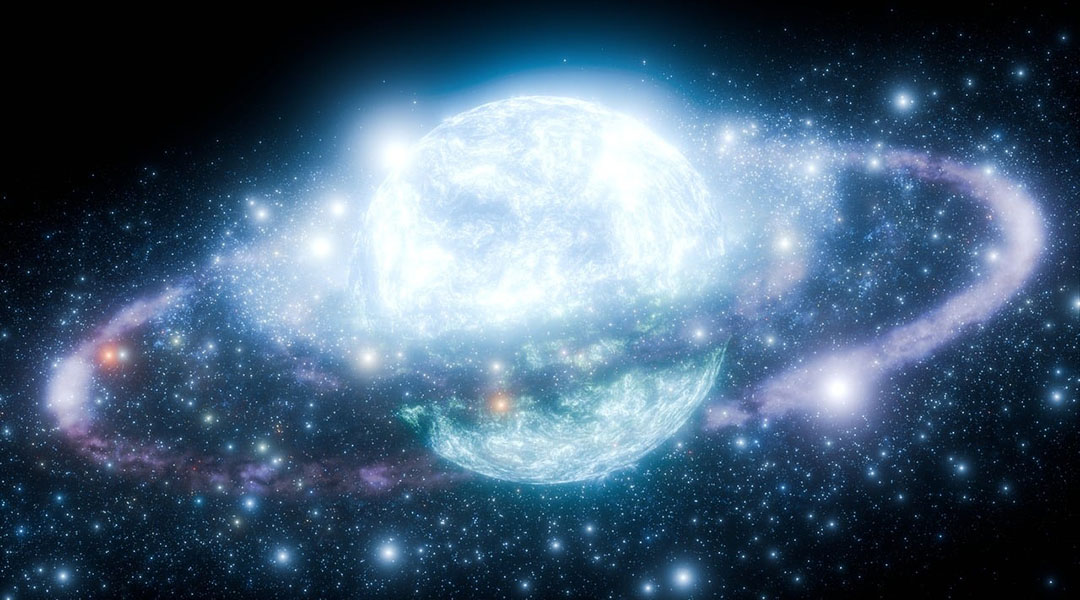Scientists have unveiled a bold new strategy to hunt down dark matter: by tracking elusive radio signals emitted by neutron stars, the remnants of massive stars are made almost entirely of neutrons and pack several times the mass of our Sun into a sphere only about 10 kilometers in diameter.
Though dark matter is thought to constitute roughly 85% of all matter in the Universe, it has never been observed directly. Scientists suspect it exists because of the gravitational effects that it has on visible matter across vast distances, yet every attempt to detect it in the lab has failed.
According to a new study, dark matter may be gathering in dense clouds around neutron stars, potentially making it easier to observe it from Earth. However, this theory holds only if dark matter consists of theorized ultralight particles called axions.
Axions are thought to have a mass many orders of magnitude smaller than that of an electron. Despite their tiny size, they are considered a strong candidate for dark matter because their theoretical properties match how dark matter behaves in the universe, such as forming halos around galaxies.
The current hypothesis suggests that neutron stars could generate and be surrounded by these axion clouds due to their extreme conditions, like strong magnetic fields. This process relies on the unique properties of axions, which allow them to behave in this way. Other dark matter candidates, such as WIMPs (Weakly Interacting Massive Particles), would not create similar clouds under the same conditions.
Neutron stars as axion factories
In an earlier study, the researchers showed that the intense electromagnetic fields in the plasma surrounding neutron stars — formed as interstellar gas is pulled in by the star’s immense gravity, accelerated, and heated to extreme temperatures — could be prime environments for axion production. The theory behind axions predicts that photons, the basic units of light and electromagnetic fields, would naturally convert into axions in such conditions.
As a step further, in their latest study published in Physical Review X, the team investigated the dynamics of axions once they are gravitationally trapped by neutron stars, aiming to determine if these particles could produce the necessary signals, such as X-rays or radio waves, that would be detectable by our telescopes.
“One of the novel […] proposals to indirectly search for axions involves looking for […] signals coming from the magnetospheres of neutron stars [regions around their surfaces with extremely strong magnetic field],” the scientists wrote. “The large magnetic fields and ambient plasma found in these environments can dramatically enhance the interaction rate between axions and electromagnetism, producing an array of distinctive signatures.”
The formation of axion clouds
Even if axions exist, their mass and the strength of their interaction with the electromagnetic field of neutron stars are not precisely known. Therefore, the scientists explored a wide range of these parameters in their analysis.
The team analyzed the life cycles of ten neutron stars, finding that the density of axions, and therefore dark matter, around them could almost reach that of liquid water — an enormous amount for the vacuum of space, where the average density is just one atom per cubic meter.
What is significant about this is that at such a high density, axions should convert into photons of light quite efficiently, and this emission could hypothetically be detected using existing telescopes, such as the Low-Frequency Array, the Murchison Widefield Array, and the Green Bank Telescope.
“We find that for typical neutron stars in our sample, the characteristic density of axions near the surface of the star can exceed the local dark matter density by more than 20 orders of magnitude over a sizable fraction of the neutron star’s lifetime,” the team wrote.
“We [also] identify a number of unavoidable […] implications of axion clouds, including the emission of a sharp spectral line at radio frequencies […]. We demonstrate that observations using current radio telescopes offer enormous discovery potential.”
Future observations
Discovering axions using this technique would be an outstanding achievement. However, even if astronomers are unable to detect them by observing radio emissions from neutron stars, the effort would still be significant. It would help to narrow down the possible mass of axions and refine our understanding of how these particles interact with electromagnetic fields, thereby offering crucial constraints on theoretical models.
Looking ahead, the researchers emphasize the need for more in-depth studies of neutron star magnetospheres and the behavior of the surrounding plasma. Another phenomenon requiring more detailed theoretical exploration is the interactions between axions and electromagnetic fields, which is key to interpreting the radio waves produced by hypothetical axion clouds.
With this deeper knowledge, present and future generations of radio telescopes may finally uncover the elusive nature of dark matter.
Reference: Dion Noordhuis et al, Axion Clouds around Neutron Stars, Physical Review X (2024). DOI: 10.1103/PhysRevX.14.041015
Feature image credit: AdisResic

















